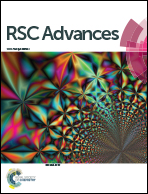Tuning the charge transfer and optoelectronic properties of tetrathiafulvalene based organic dye-sensitized solar cells: a theoretical approach†
Abstract
Here, we have designed a series of dyes following the donor–π–acceptor (D–π–A) architecture by incorporating tetrathiafulvalene (TTF) as the donor unit and phthalazine (PTZ), diketopyrrolopyrrole (DPP) and quinoxaline (QNX) as the acceptor units, along with the thiophene unit as a π-bridge. The designed dyes have been designated as TTF-PTZ, TTF-DPP and TTF-QNX respectively. We have used cyanoacrylic acid as the anchoring group for the dyes TTF-PTZ and TTF-DPP, while for the third dye, TTF-QNX, we used a carboxylic group. The structural, electronic and photochemical properties of the designed dyes are investigated under the regime of density functional theory (DFT) and time-dependent density functional theory (TD-DFT) methods. In this regard, the dihedral angle, energies of the highest occupied molecular orbital (HOMO) and lowest unoccupied molecular orbital (LUMO), energy difference between the HOMO and LUMO (ΔH–L values), partial density of states (PDOS), ground state oxidation potential (GSOP), excited state oxidation potential (ESOP), ionization potential (IP), electron affinity (EA), molecular electrostatic potential surface (MEPS) analysis, reorganization energy (λ), electronic coupling matrix element (V), charge transfer rate (kCT), hopping mobility (μhop), absorption spectra, exciton binding energy (EBE) and electron density difference (EDD) of the designed dyes are calculated. This study reveals that the dyes TTF-DPP-4 and TTF-DPP-6′ exhibit the lowest ΔH–L values. The study also reveals that the attachment of the –NH2 group at the donor unit and the –NO2 and –CF3 groups at the acceptor units lower the ΔH–L values of all of the designed dyes. We have also observed that the GSOP of all the designed dyes lie below the redox potential of the I−/I3− electrolyte couple. However, the ESOP of the TTF-PTZ and TTF-QNX groups of dyes, along with the most of the dyes belonging to the TTF-DPP group, lie above the conduction band of the TiO2 semiconducting surface. Moreover, the total reorganization energy (λtot) values are low for the TTF-DPP and TTF-QNX groups of dyes, which confirm the better electron–hole separation efficiency in these groups of dyes. Furthermore, the absorption properties of the designed dyes indicate that the TTF-DPP groups of dyes possess the maximum absorption wavelength (λmax) values and attachment of the –CH3 group at the donor part increases the electron density of the dyes, which in turn results into the maximum red-shift. Therefore, the study reveals that the designed dyes are likely to exhibit facile charge transport. Moreover, the electronic properties of the dye–TiO2 clusters strengthen the performance of the dyes compared to those of the isolated dyes. Hence, our study provides good recommendations for the further design of dyes to enhance the performance of dye-sensitized solar cells (DSSCs).



 Please wait while we load your content...
Please wait while we load your content...